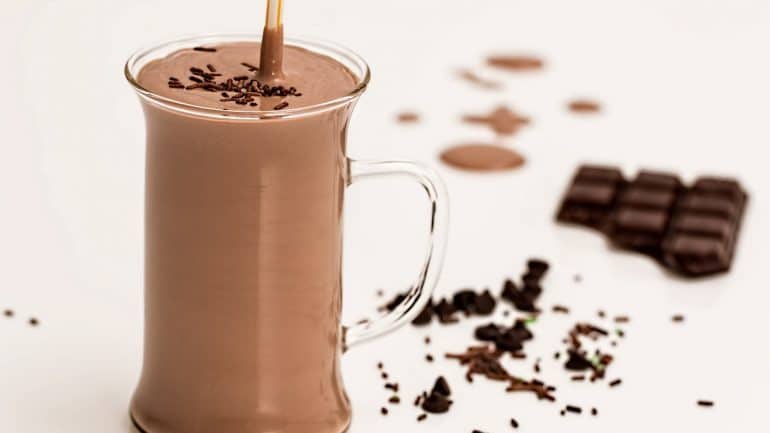37 Mouth-Watering Chocolate Facts and Statistics for 2024
written by / January 20, 2022
There’s nothing better than the rich and smooth taste of chocolate melting on your tongue. And every chocolate aficionado knows that this delicious treat has numerous health benefits as well. According to the chocolate facts, this delicacy has also had numerous different roles throughout the history of humanity.
If you want to become a real chocolate connoisseur, keep reading. You’ll find out more about chocolate and its origin, the different types of chocolate, the chocolate industry, how it impacts your health and sleep, and much more. We’ll also debunk a few myths about chocolate and answer some of the most frequently asked questions.
But first, let’s take a look at some of the most interesting statistics and facts about everyone’s favorite candy.
The Top 10 Most Impressive Chocolate Statistics and Facts for 2022
- The Olmecs of Mexico were the first civilization to use cacao beans in 1500 BC.
- British confectioners invented the first chocolate bar in 1847.
- The scientific name of the cacao tree literally translates to “food of the gods.”
- Chocolate was used as a currency.
- Dark chocolate with 75–85% cocoa solids can provide us with 11g of fiber.
- Approximately 20% of all the chocolate consumed in the US is dark chocolate.
- Spain was the first country to introduce milk chocolate to Europe in the 1600s.
- Chocolate milk was invented in Jamaica in the 1700s.
- Manufacturers produce more than 90 million chocolate Easter bunnies every year.
- People can actually die if they eat too much chocolate—22 pounds, to be exact.
Chocolate History Facts

Want to know a little more about the history of your favorite treat? In this section, we’ll be looking at where chocolate comes from and more.
1. The Olmecs of Mexico were the first civilization to use cacao beans in 1500 BC.
(Divine Chocolate, Smithsonian Magazine)
Some 3,500 years ago, cacao beans grew wild in Central America. The word “chocolate” actually comes from the Aztec word “xocolatl,” which literally translates to “bitter water.” In 1500 BC, chocolate had a very different taste, hence the name.
2. The first chocolate treat was hot chocolate, not a chocolate bar.
(History)
According to the chocolate facts, hot chocolate was used in rituals and ceremonies—like weddings—in both Mexican and Aztec cultures. It was rather bitter due to the lack of sugar in those times, so it tasted nothing like the delicious hot chocolate we consume today.
3. The ancient Mayans were the first real chocolate admirers.
(Divine Chocolate)
They used a mixture of spices to make hot chocolate, and historians have even found their recipe. These hot chocolate facts reveal that the ancient recipe requires unsweetened cocoa powder, star anise, maize, cloves, cinnamon, chili powder, vanilla, and annatto.
4. British confectioners invented the first chocolate bar in 1847.
(Wired)
J. S. Fry & Sons invented what they called the “eating chocolate.” That’s the first-ever chocolate bar as we know it today. They combined sugar and cocoa butter to create the delicious treat.
5. The scientific name of the cacao tree literally translates to “food of the gods.”
(The Nibble)
It was Carl von Linné who gave a name to the cacao tree. He named it “Theobroma,” which is Greek for “food of the gods.” So they didn’t just eat chocolate for fun. According to the facts, it was also considered divine.
6. Chocolate was used as a currency.
(Smithsonian Magazine)
Cacao beans were so popular in the times of the ancient Mayans and Aztecs that they were used as a currency. People would even make counterfeit beans from clay. However, there are other records of similar practices. Namely, the Revolutionary War soldiers were sometimes paid in chocolate too. As chocolate doesn’t spoil quickly, it’s very convenient as a currency.
Dark Chocolate Facts
Here, we’ll be discussing some interesting facts about dark chocolate.
7. Dark chocolate has 50–90% cocoa solids, sugar, and cocoa butter.
(Harvard T.H. Chan)
On the other hand, milk chocolate has only 10–50% cocoa solids and butter, milk, and sugar. The higher the percentage of cocoa solids, the healthier the chocolate will be. Also, it’s worth knowing that dark chocolate shouldn’t contain any milk.
8. Dark chocolate with 75–85% cocoa solids can provide us with 11g of fiber.
(Medical News Today)
When it comes to dark chocolate, nutrition facts reveal that this chocolate type is not only tasty, but it’s also very healthy. A dark chocolate bar weighing 101g will provide you with 7.87g of protein, 12.02mg of iron, 230mg of magnesium, and 3.34mg of zinc. It’s also rich in antioxidants and has numerous anti-inflammatory effects.
9. Approximately 20% of all the chocolate consumed in the US is dark chocolate.
(Phys)
According to the Dietary Guidelines Advisory Committee and their study on chocolate and nutrition, facts reveal that dark chocolate can be an everyday part of a healthy, balanced diet. However, it’s also recommended to be consumed in moderation, since it’s very high in calories.
10. Two oz of 70% dark chocolate contains approximately 50–60mg of caffeine.
(Harvard T.H. Chan)
It’s already mentioned that the higher the percentage of cocoa solids, the healthier the dark chocolate is. However, there’s also an increase in caffeine content. As per chocolate stats, an 8 oz cup of coffee has 100–200mg of caffeine.
11. Eating dark chocolate more than 5 times a week reduces the risk of heart disease by 57%.
(Healthline)
However, this is not the only health advantage of dark chocolate. It can also lower the chances of calcified plaque buildup in the arteries and improve brain function. It’s also proven that dark chocolate lowers the levels of high blood pressure and improves blood flow.
Milk Chocolate Facts
In this section, we’ll be looking at milk chocolate in detail.
12. Spain was the first country to introduce milk chocolate to Europe in the 1600s.
(Taste Essence)
However, the first commercial milk chocolate bars were made in the 1800s by the English Cadbury company. They are to date considered to be the makers of some of the tastiest chocolate ever created.
13. One cacao tree can produce cacao seeds for only 8 milk chocolate bars.
(Divine Chocolate)
One cacao tree can produce about two harvests a year, which approximately gives about 50 pods of cacao seeds. When we look at the difference between dark chocolate vs. milk chocolate, statistics show that every pod has around 40 cacao beans in the shape of an almond, which is enough to make eight milk chocolate bars or only four dark chocolate bars.
14. Milk chocolate bars have a higher caffeine content than a shot of espresso.
(The Coca-Cola Company)
Dark chocolate bars aren’t the only ones with high levels of caffeine. Milk chocolate bars are also rich in this ingredient. An average milk chocolate bar has about 50mg of caffeine. However, milk chocolate is by far tastier.
15. The facts about milk chocolate derived from one Harvard study revealed that those who eat chocolate live almost 1 year longer than those that don’t.
(Daily Mail)
Milk chocolate can also ease the pain of age-related arthritis. The patients only need to eat 12 squares of chocolate every 24 hours, and they should soon feel better. Of course, chocolate cannot cure arthritis, but it helps.
16. Milk chocolate has 100mg more calcium than dark chocolate.
(Everyday Health)
According to the latest milk chocolate findings, nutrition facts show that one milk chocolate bar has more calcium and iron than one average dark chocolate bar. However, this is also the reason why one average milk chocolate bar has more calories than a dark one.
17. White chocolate is actually not chocolate.
(bon appétit)
It doesn’t taste like chocolate either. White chocolate is made from cocoa butter, vanilla, sugar, milk products, and a fatty substance called lecithin. So white chocolate is actually not chocolate, according to the facts. Even though it has cocoa butter, it doesn’t have cocoa solids, and they are the most important component of chocolate.
18. There are 4 chocolate types.
(The Daily Meal)
Frédéric Bau, the founding director of the school of pastry and chocolate craft L’École du Grand Chocolat Valrhona—a fine chocolates manufacturer—has invented a new type of chocolate he calls “blonde chocolate.” It has a toasty and creamy texture, a subtle caramelized milk taste, and a one of a kind color—it’s blonde!
Chocolate Milk Facts

Love chocolate milk? You’ll enjoy this section.
19. Chocolate milk was invented in Jamaica in the 1700s.
(Natural History Museum)
The Natural History Museum states that an Irish botanist, Sir Hans Sloane, invented chocolate milk as we know it today. While in Jamaica, Sir Sloane was given straight cocoa as a drink by the land’s native people. However, he couldn’t drink it that way, so he added some milk and created everyone’s favorite chocolate drink.
20. Chocolate milk is a fantastic post-workout recovery drink.
(Healthline)
When it comes to chocolate milk, nutrition facts show that—just like regular milk—chocolate milk is very rich in nutrients and is a great source of magnesium, selenium, zinc, iodine, and vitamins A, B1, B6, and B12. It’s also rich in calcium, making it great for the health and strength of our bones.
21. People with lactose intolerance can probably tolerate chocolate milk.
(The Dairy Alliance)
One research has discovered that lactose-intolerant people can stomach chocolate milk much better than the plain one. Some facts about chocolate milk suggest that this is due to the cocoa, which slows stomach emptying and gives our bodies more time to break down the lactose.
22. More than 16 million American adults believe that chocolate milk comes from brown cows.
(The Washington Post, Business Insider)
That is more than 7% of the nation. Of course, this is wrong, and they are terribly misinformed. Additionally, over 48% of them didn’t even know how chocolate milk is actually made. Chocolate milk is made from cow’s milk, cocoa, and sugar.
Fun Facts about Chocolate
Here, we have some intriguing fun facts about this delicious treat.
23. September 13th is International Chocolate Day.
(Mental Floss)
There are several holidays dedicated to chocolate throughout the year. July 7th is Chocolate Day—a day when chocolate was first brought to Europe. The National Milk Chocolate Day is celebrated on July 28th, and National Bittersweet Chocolate With Almonds Day happens on November 7th.
24. Manufacturers produce more than 90 million chocolate Easter bunnies every year.
(ABC News Network)
Additionally, people consume more than 70 million pounds of chocolate every Easter, according to the chocolate statistics. Furthermore, chocolate bunnies are the most popular of all sweets and 76% of Americans say that they eat this treat ears first.
25. The largest chocolate bar in the world weighed more than 12,000 pounds.
(World Record Academy)
Thorntons company created this massive chocolate bar to celebrate their 100th birthday. It weighed exactly 12,770 pounds or 5,792.50 kilograms, and it broke all the records.
26. Every Valentine’s Day, people buy more than 36 million heart-shaped chocolate boxes.
(Adweek)
People love Valentine’s Day, and the chocolate statistics clearly show that, on that day, chocolate is the most sought after elixir for broken hearts. There are tales that chocolate awakens the feeling of love in both men and women alike. Even Casanova preferred chocolate to champagne when it came to fueling romance.
27. Brussels Airport sells approximately 800 tons of chocolate every year.
(Brussels Express)
That’s close to two tons every day. The airport sells the finest Belgian chocolate, which may be the reason for such high numbers. When it comes to Belgium, the chocolate facts reveal that this country has the world’s biggest chocolate factory, and it produces 270,000 tons of chocolate annually.
28. The first chocolate chip cookie was created by accident.
(Epicurious)
In the 1930s, Ruth Wakefield, the owner of the Toll House Inn in Whitman, Massachusetts, added pieces of broken chocolate into her cookie batter, thinking they would melt while baking. This is how she invented the delicious chocolate chip cookies, according to the facts. Moreover, Nestlé gave Ruth a lifetime supply of chocolate in exchange for the recipe.
29. People can actually die if they eat too much chocolate—22 pounds, to be exact.
(Telegraph)
Everyone knows that chocolate is dangerous for cats and dogs, but it can also be dangerous for people. Chocolate has high levels of theobromine, which can cause seizures, heart failure, dehydration, and acute kidney damage. However, one would have to eat more than 40 Dairy Milk bars in one sitting for this to happen.
Chocolate Facts and Myths
There are many myths about chocolate. In this section, we’ll be debunking some of those myths.
30. Myth: Chocolate can cause acne.
(Runtastic)
It’s believed that if you eat more sugary and fatty foods, your skin will produce more oil, and therefore you will get acne. However, it actually depends on the type of skin you have. People with oily skin are usually advised to watch their diet.
31. Myth: Chocolate is bad for teeth.
(Spark People)
Candies, in general, are not responsible for cavities. According to the health facts about chocolate, cavities are usually caused by a bacteria that lives in the mouth and processes sugar and starches into acid that damages teeth. This can easily be avoided by maintaining healthy oral hygiene and through the regular use of fluoride.
32. Myth: People who suffer from diabetes can’t eat chocolate.
(BHF)
People with diabetes can eat chocolate in moderation. It’s recommended that they consume it after a meal so that their bodies can absorb the sugar more slowly. Some of the facts about chocolate also state that regular chocolate is healthier than diabetic chocolate since diabetic products are often very high in fats and energy.
33. Myth: Chocolate must have at least 70% cacao to be considered healthy.
(MNN)
Chocolate with higher levels of cacao indeed has more antioxidants, but every chocolate brings different health benefits, no matter the cacao levels, or if it’s dark or milk chocolate. Dark chocolate is good for the brain, heart, and blood pressure. However, our chocolate facts have shown that milk chocolate is good for the bones, due to the calcium from milk.
34. Myth: Cocoa and cacao are the same.
(Nuts)
Despite their similar spelling and pronunciation, these two are actually different things. Cacao is the rawest form in which you can consume chocolate, and it comes directly from cacao seeds. Cocoa, on the other hand, is produced when cacao is cleaned and roasted at high temperatures, and it comes in the form of a powder.
Interesting Facts about Chocolate and Sleep

Did you know that chocolate can help you sleep better? Here, we’ll be discussing some interesting facts about sleep and chocolate.
35. Dark chocolate can actually help you fall asleep faster.
(Good Housekeeping)
Some foods help you sleep, and some cause the opposite effect. Despite its high levels of caffeine, chocolate can be helpful for sleep, since it contains serotonin. Serotonin is a neurotransmitter that is responsible for raising one’s levels of happiness. Additionally, it relaxes the body and the mind and thus helps with falling asleep.
36. Chocolate can also cause violent nightmares.
(Frontiers in Psychology)
Chocolate statistics state that although it can help you fall asleep faster, chocolate can also cause nightmares. The caffeine and sugar from chocolate are linked to bad dreams, so it’s advised to eat only small amounts of chocolate before bed.
37. Chocolate counteracts the negative effects of sleep deprivation.
(Relias Media)
One study found that one bar of dark chocolate (80% cacao) can counteract the effects of sleep deprivation and especially its cardiovascular repercussions. Due to this, cocoa flavonoids are recommended as a supplement or aid in sleeping disorders.
The Bottom Line
From 1500 BC until today, chocolate has come a long way, from a bitter drink and a currency to the most luxurious delicacy in the world. We know that people need no excuse to eat chocolate, but we hope that these chocolate facts for 2022 have shown you how good it is for your overall health.
Chocolate makes us happy, keeps us young, and helps us relax and fall asleep easier. Moreover, it’s the perfect gift for any occasion. No wonder it has been the most popular treat for the last 3,500 years.








